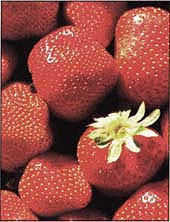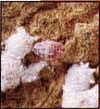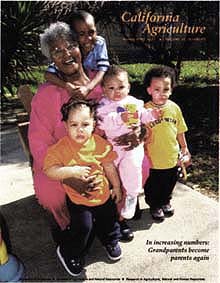All Issues
Letters
Publication Information
California Agriculture 55(4):5-6.
Published July 01, 2001
PDF | Citation | Permissions
Full text
Methyl iodide vs. methyl bromide
Articles in the May-June issue of California Agriculture list alternatives to methyl bromide but omit discussion of methyl iodide. Our studies indicate that methyl iodide is the only single potential replacement that is at least as effective as methyl bromide and has a similar spectrum of activity.
In contrast to many of the cited alternatives, we have subjected our research findings to rigorous scientific peer review. Consequently, we have published 10 articles in refereed journals and given numerous talks at local, national and international meetings. UC has been granted two patents on the use of methyl iodide as a soil fumigant. The UC patents were licensed by Tomen Agro, Inc., which is currently in the process of gathering the information necessary for registration by the U.S. Environmental Protection Agency (EPA) and California Department of Pesticide Regulation (CDPR). Tomen Agro is planning to submit the package early in 2002, using the alternate name iodomethane.
The bottom line from our studies is that methyl iodide can replace methyl bromide without a major change in application technology. The main advantage over methyl bromide is that it is not an ozone-depleting substance. It is destroyed by photochemical reactions at the earth's surface. Furthermore, methyl iodide is a liquid at ambient temperature, which should increase worker safety. Finally, methyl iodide is effective at rates approximately one-third lower than methyl bromide.
What are the possible downsides? Methyl iodide is a toxic chemical similar to methyl bromide. The same safety precautions must be observed to avoid exposure. Still, in contrast to many other synthetic pesticides, methyl iodide is a naturally occurring metabolite of fungi and plants. From an economic standpoint, methyl iodide is currently considerably more expensive than methyl bromide as it is produced only in small quantities. Supply and demand will ultimately determine the cost. On the other hand, a restricted regulatory framework combined with relatively high cost guarantees that soil fumigation will remain reserved only for important indications such as nursery and perennial crop production.
James J. Sims, Department of Plant Pathology J. Ole Becker, Department of Nematology UC Riverside
Plug plants in California
The statement in the May-June research update (p. 10) that strawberry plug plants “are used successfully in other strawberry-growing regions but not California,” is false.
Pacific Ag Group has pioneered this technology with over 5 years of testing, planting and marketing of strawberry plug plants for commercial growers in California. This program is headquartered at our private research facility in San Luis Obispo, where we conduct a broad-based methyl bromide alternatives research program that includes chemical fumigants, biological and microbial soil products, and utilization of cultural practices such as the strawberry plug plant.
During the 2000-2001 growing season, more than 1 million strawberry plug plants were planted statewide. This year, the use of this technique will more than double. This increase can be directly attributed to their ability to out-perform conventional bare-root plants for earlier and overall yields in a variety of soil conditions. This includes both soils fumigated with methyl bromide alternatives, as well as organic and unfumigated soil. Our results have been published and we have received financial support from EPA, CDPR and several California growers.
While this technique will not entirely replace conventional bare-root nursery production, it offers California growers an option for early production in variable soil conditions. We will continue to develop this technique for wider use through research and development activities and the excellent cooperation of California strawberry growers.
Dr. Frank Sances, Director
Pacific Ag Group
San Luis Obispo
Correction
After press time, the authors of “Sampling Program for grape mealybugs improves pest management” (May-June 2001,p.23), corrected a statement in the sidebar identifying mealybugs. The pink hibiscus mealybug (shown) was recently discovered in five urban areas in Imperial County, but not in the Coachella Valley. Ongoing surveys by state officials have not revealed this pest in any agricultural area to date.
Editor's note: According to UC Davis pomologist Kirk Larson, despite public and private research on strawberry plug plants, less than 0.2% of the 1 billion strawberry runners planted statewide in the 2000-2001 growing season were plug plants. Larson notes, “A major limitation to the use of plug plants in California is that they produce an abundance of poor-quality fruit (small fruit size and poor shape), serious drawbacks that often outweigh any early-season yield advantages. At UC we are attempting to improve plug plant performance by conditioning plugs in high-elevation nursery sites.”
Grandparents and agriculture?
I have been receiving and reading California Agriculture for almost 30 years and have always appreciated the work reported, even though it did not always apply to my area of agriculture. I am curious as to what the purpose of your magazine is now when the cover story (March-April 2001) has to do with grandchildren being raised by grandparents. Is California Agriculture now a sociology publication? Do they not have their own forum?
Don Roberts
Redding
Editor's response: The answer can be seen in the small line of type at the bottom of the cover of California Agriculture, which says “Research in Agricultural, Natural and Human Resources.”
Family and consumer sciences are part the Cooperative Extension function of the land-grant university, and have been for decades. Today the UC Division of Agriculture and Natural Resources includes a group of human resources faculty located at the UC Davis and Berkeley campuses and others in county offices around the state. These faculty specialize in human health and nutrition, work-force preparedness, financial and resource management, human relationships and science literacy.
Author Mary Blackburn is a family and consumer sciences advisor in the Alameda County Cooperative Extension office. The increasing national trend toward more children raised by grandparents or other family members is a troubling one for reasons described fully in the article. When established in the late 19th century, land-grant universities were given the mission of bringing the university to the people. The resources of the land-grant university have been applied to such problems in the past and are being applied to such problems today.
Red-legged frog decline
I was disappointed with the biased and unscientific science brief in the May-June issue (p. 5) on the decline of red-legged frogs and pesticides. There is no proof of such a link, just speculation. The article used words such as “suggesting,” “may,” “may well be” and “if pesticides are the cause.” More importantly, the influence of parasites, disease and exotic/introduced organisms was not measured.
The “significant correlation” was not between “agricultural drift,” but between (prevailing?) wind direction and the presence of the frogs. Correlation alone is only suggestive: much more research would be required to determine why this correlation occurred and to identify the causal factors.
William H. Day, Research Entomologist
U.S. Department of Agriculture
Newark, Delaware
Editor's note: The item in question was a science brief, which summarized a peer-reviewed journal article appearing in Ecological Applications (Vol. 11, No. 2).
H. Bradley Shaffer, co-author of the Ecological Applications article, responds:
Dr. Day's response to our paper appears to find our use of correlational studies unacceptable. As we state in the original article, correlation does not prove causation. However, correlational analyses at a statewide level can provide compelling indications that some factors are implicated in amphibian declines, and others are less likely to be important.
We found that the amount of agricultural development upwind from a site reliably predicts whether red-legged frogs have disappeared from that site, but the amount of agricultural land downwind or in a random direction has no such predictive value.
We propose the reasonable interpretation that windborne agrochemicals may be a factor (we looked at three other potential factors) that has led to the precipitous decline of this species. As we and others follow up on this study with additional analyses of other species, and experimental studies of the effects of specific agrochemicals, we hope to be able to determine the mechanistic basis of our observation. In our experience, this is the normal course of science — start with statistically supported observations and use replication and experimentation to further explore their effects.







